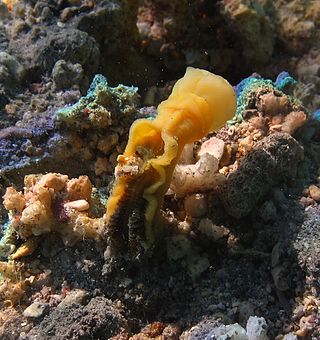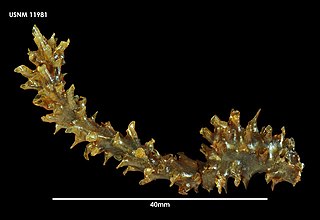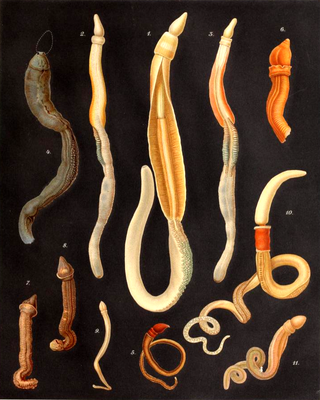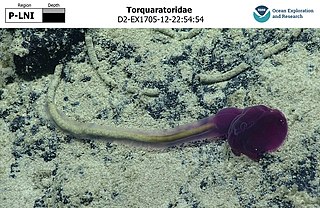
An oak is a hardwood tree or shrub in the genus Quercus of the beech family. They have spirally arranged leaves, often with lobed edges, and a nut called an acorn, borne within a cup. The genus is widely distributed in the Northern Hemisphere; it includes some 500 species, both deciduous and evergreen. Fossil oaks date back to the Middle Eocene. Molecular phylogeny shows that the genus is divided into Old World and New World clades, but many oak species hybridise freely, making the genus's history difficult to resolve.

Hemichordata is a phylum which consists of triploblastic, enterocoelomate, and bilaterally symmetrical marine deuterostome animals, generally considered the sister group of the echinoderms. They appear in the Lower or Middle Cambrian and include two main classes: Enteropneusta, and Pterobranchia. A third class, Planctosphaeroidea, is known only from the larva of a single species, Planctosphaera pelagica. The class Graptolithina, formerly considered extinct, is now placed within the pterobranchs, represented by a single living genus Rhabdopleura.

Balanoglossus is a genus of ocean-dwelling acorn worms (Enteropneusta). It has zoological importance because, being hemichordates, they are an "evolutionary link" between invertebrates and vertebrates. Balanoglossus is a deuterostome, and resembles the sea squirts (Ascidiacea) in that it possesses branchial openings, or "gill slits". It has a notochord in the upper part of the body and has no nerve chord. It does also have a stomochord, which is however a gut chord within the collar. Their heads may be as small as per 2.5 mm (1/10 in) or as large as 5 mm (1/5 in).

Pterobranchia, members of which are often called pterobranchs, is a class of small worm-shaped animals. They belong to the Hemichordata, and live in secreted tubes on the ocean floor. Pterobranchia feed by filtering plankton out of the water with the help of cilia attached to tentacles. There are about 25 known living pterobranch species in three genera, which are Rhabdopleura, Cephalodiscus, and Atubaria. On the other hand, there are several hundred extinct genera, some of which date from the Cambrian Period.

The acorn worms or Enteropneusta are a hemichordate class of invertebrates consisting of one order of the same name. The closest non-hemichordate relatives of the Enteropneusta are the echinoderms. There are 111 known species of acorn worm in the world, the main species for research being Saccoglossus kowalevskii. Two families—Harrimaniidae and Ptychoderidae—separated at least 370 million years ago.

Harrimaniidae is a basal family of acorn worms. A taxonomic revision was undertaken in 2010, and a number of new genera and species found in the Eastern Pacific were described. In this family the development is direct without tornaria larva, and circular muscle fibers in their trunk is missing. There is some indication that Stereobalanus may be a separate basal acorn worm lineage, sister to all remaining acorn worms.

Ptychoderidae is a family of acorn worms.
Yoda purpurata is a species of acorn worm discovered 2.5 km below the surface of the Atlantic ocean, and was the first of the genus Yoda found. Ranging from 12 to 19 cm in length, it was named after the fictional character Yoda from the Star Wars franchise. It was the first known hermaphroditic member within the phylum. The other known hermaphroditic member of the phylum is Yoda demiankoopi discovered in 2021.

Torquaratoridae is a family of acorn worms (Hemichordata) that lives in deep waters between 350 and 4000 meters. They can grow up to three feet in length and have semitransparent gelatinous bodies, often brightly colored.

Meioglossus psammophilus is a species of acorn worm in the family Harrimaniidae, the only known species of the genus Meigolossus. It inhabits the Western Caribbean and Bermuda. The name of the species derives from two Greek words; psammon and philos which in translation means friend of the sands in reference to adult stage of species' lifestyle. The length of the species is 0.6 millimetres (0.024 in). It is able to reproduce asexually through paratomy.
Mesoglossus intermedius is a species of acorn worms in the family Harrimaniidae, which is endemic to Northern California.
Spartobranchus tenuis is an extinct species of acorn worms (Enteropneusta). It existed in the Middle Cambrian. Petrified mark animals were found in British Columbia, Canada in the Burgess Shale formation. It is similar to the modern representatives of the family Harrimaniidae, distinguished by branching fiber tubes. It is a believed predecessor of Pterobranchia, but this species is intermediate between these two classes. Studies show that these tubes were lost in the line leading to modern acorn worm, but remained in the extinct graptolites. However recently Antarctic torquatorids have been found that also make tubes.
Saccoglossus bromophenolosus is a species of acorn worm occurring in the northwestern Atlantic Ocean and the northeastern Pacific Ocean. It grows to a length of about 20 cm (8 in) and lives in a burrow in soft sediment in the intertidal and subtidal zones. The scientific name refers to 2,4-dibromophenol, a secondary metabolite present in this worm.
Cornelius Jan van der Horst was a Dutch biologist who worked mainly on marine biology and embryology in both the Netherlands and South Africa. As an undergraduate he studied botany and zoology at the University of Amsterdam where he was appointed assistant in the Botany Department under Professor Dr Hugo de Vries before moving on to assist Max Wilhelm Carl Weber at the University's Zoological Museum and in 1917 he became the principal assistant for general Zoology. In 1916 he published his thesis De motorische kernen en banen in de hersenen der visschen. Hare taxonomische waarde en neurobiotactische beteekenis. The research for this thesis was carried out at the Netherlands Central Institute for Brain Research under C. U. Ariëns Kappers. In 1925 Van der Horst was appointed Deputy Director of this Netherlands Central Institute for Brain Research and in 1928 he moved to South Africa where he took up a post as senior lecturer in zoology at the University of the Witwatersrand in Johannesburg. in 1932 he was promoted to professor in zoology at this University.
Stereobalanus is a genus of acorn worms belonging to the family Harrimaniidae.

Glossobalanus is a genus of worms belonging to the family Ptychoderidae.
Mesoglossus is a genus of worms belonging to the family Harrimaniidae.
Ritteria is a monotypic genus of worms belonging to the family Harrimaniidae. The only species is Ritteria ambigua.
Mongeperipatus is a genus of velvet worms in the family Peripatidae from Costa Rica. The biologists José Pablo Barquero-González, Steven Sánchez-Vargas, and Bernal Morera-Brenes introduced this genus in 2020 to contain the newly discovered type species, M. kekoldi, together with another species, M. solorzanoi. A phylogenetic analysis using DNA sequences placed these two species in their own monophyletic clade. Furthermore, these two species share morphological characters that indicate that these species do not belong in the other genera and instead belong together in a separate genus. The genus Mongeperipatus is named in honor of the Costa Rican biologist Julián Monge-Nájera.









